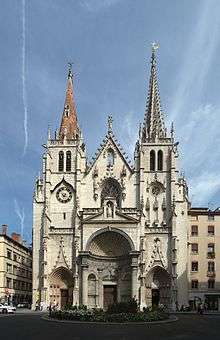Occupation of Saint-Nizier church by Lyon prostitutes
The occupation of Saint - Nizier church by Lyon prostitutes refers to the ten-day occupation of the Saint-Nizier Church in Lyon by more than a hundred prostitutes on 2 June 1975 to draw attention to their inhumane working conditions.[1][2][3] The occupation lasted eight days until the women were removed by the police on 10 June. Sympathetic occupations of churches by prostitutes followed in Paris, Marseille, Grenoble, Saint-Étienne and Montpellier.[4]

Background
In the 1970s, French police kept sex workers under increasing pressure. The police reprisals[1] forced sex workers to work increasingly in secret. As a result, protection of sex workers decreased and led to more violence against them. In April 1975, the Lyon prostitutes started to organise themselves and their leader, "Ulla" appeared on television to publicise the women's demands.[4] After three murders and the unwillingness of the government to improve the situation, sex workers in Lyon took action.[5]
Occupation
On 2 June 1975 more than 100 prostitutes occupied the Saint-Nizier church in rue de Brest and went on strike.[6] They demanded the end of fines, police harassment[4] and the release from jail of ten of them who had been imprison a few days earlier for soliciting.[6][7] The striking workers sang political chants and demanded decent working conditions and an end to stigma.
The occupation made national headlines and was reported internationally. Local people supported the woman and brought clothes and food. The occupation received support from political, union and feminist organisations.[8][9] Abolitionists, in the form of the Movement du Nid,[10][11] also supported the occupation, hoping the public awareness it raised would help end prostitution.[4]
The parish priest, the Rev. Antonin Bdal, refused to call the police to remove the women.[12] However, acting on Government orders,[4] the police forcibly cleared the church after eight days on 10 June.[13] The Minister of the Interior, Michel Poniatowski,[12] claimed the women had been manipulated into the occupation by pimps,[4] and the Women rights Minister, Françoise Giroud, refused to meet with the women[12] and claimed she was not competent in the matter.[4] The leader of the Movement, "Ulla", had her real name and photograph printed in the press.[4]
The event marks the starting point of an international movement of sex workers for sex workers' rights.[14][15]
Legacy
The occupation is remembered every year on 2 June as International Whores' Day.[1]
A journalist working for Libération, Claude Jaget, followed the occupation. In addition to his articles in Libération, he later published a book: Une vie de putain.[16] This book gathers six testimonies, from among the prostitutes who participated in the occupation of the church.[17]
In 2016, a play, Loveless, written by Anne Buffet and Yann Dacosta, an adaptation of the book, Une vie de putain,[18] was enacted at the National Dramatic Center of Normandy-Rouen[17] it was also staged in Lyon at the Théâtre des Célestins in 2018.[19]
References
- "Internationaler Hurentag – Kirche soll Prostituierte nicht ausgrenzen (International Whores' Day: The church shouldn't exclude the prostitutes)" (in German). Die Welt - Online. 2009-06-07. Retrieved 2011-06-02.
- "Prostitution: 40 ans après l'occupation de l'église Saint-Nizier, rien n'a changé". Le Point (in French). 1 June 2015. Retrieved 16 February 2019.
- Zancarini, Michelle (19 June 1995). "Il y a 20 ans, le conflit des prostituées de Saint-Nizier - Ina.fr". Lumières sur Rhône-Alpes. Retrieved 16 February 2019.
- "Occupation of St-Nizier church". Global Network of Sex Work Projects. 25 February 2015. Retrieved 16 February 2019.
- Lilian 2001, p. 112.
- Lilian 2001, p. 107.
- Hendrik, Helga & Altink 2017, p. 237.
- Lilian 2001, pp. 107, 124-127.
- Grant 2014, p. 114.
- Lilian 2001, p. 121.
- Davies 2009, p. 65.
- Farnsworth, Clyde (7 June 1975). "200 Prostitutes of Lyons in Siege at Church". The New York Times. Retrieved 16 February 2019.
- "Internationaler Hurentag in Bochum (International Whores' Day in Bochum)" (in German). Bochumer Stadt- und Studierendenzeitung (bsz). 2010-05-17. Retrieved 2013-06-02.
- "Sag mir, wer die Huren sind (Tell me, where are the whores?)" (in German). Sexclusivitäten - Laura Méritt. Retrieved 2013-06-02.
- Basaran et al. 2016, p. 193.
- Jaget 1975.
- "LOVELESS D'après " Une vie de putain " de Claude Jaget/Anne Buffet et Yann Dacosta" (in French). Centre dramatique national de Normandie-Rouen. Retrieved 16 February 2019.
- Mafra, Antonio (13 March 2018). "Putains de vie !". www.leprogres.fr (in French). Retrieved 16 February 2019.
- "Le spectacle " Loveless " revient sur la révolte des prostituées lyonnaises en 1975". Rue89Lyon (in French). 12 March 2018. Retrieved 16 February 2019.
Bibliography
- Basaran, Tugba; Bigo, Didier; Guittet, Emmanuel-Pierre; Walker, R. B. J. (2016). International Political Sociology: Transversal Lines. Routledge. ISBN 9781317435907.CS1 maint: ref=harv (link)
- Davies, John (2009). 'My Name is Not Natasha': How Albanian Women in France Use Trafficking to Overcome Social Exclusion (1998-2001). Amsterdam University Press. ISBN 9789053567074.CS1 maint: ref=harv (link)
- Grant, Melissa Gira (2014). Playing the Whore: The Work of Sex Work. Verso Books. ISBN 9781781683231.CS1 maint: ref=harv (link)
- Hendrik, Wagenaar; Helga, Amesberger; Altink, Sietske (2017). Designing Prostitution Policy: Intention and Reality in Regulating the Sex Trade. Policy Press. ISBN 9781447324249.CS1 maint: ref=harv (link)
- Jaget, Claude (1975). Une vie de putain (in French). Presses d'aujourdhui.CS1 maint: ref=harv (link)
- Lilian, Mathieu (2001). "Une mobilisation improbable : l'occupation de l'église Saint-Nizier par les prostituées lyonnaise" (PDF). Revue Française de Sociologie. 42 (1): 107–131.CS1 maint: ref=harv (link)
In media
- Les prostituées de Lyon parlent, documentary film by Carole Roussopoulos, 46 minutes, production: Video Out1, 1975 (EAN 3700301014634)
- La révolte des prostituées de Saint-Nizier, radio documentary by Eurydice Aroney and Julie Beressi for France Culture